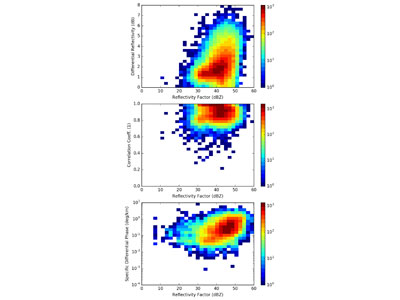| Differential reflectivity, correlation coefficient and specific differential phase along reflectivity factor of Essen C-band radar from 2016-06-24. The data is filtered by a 35db signal-to-noise threshold and excludes data from radials, which may contain hail or are in the shadow of hail. Presence of hail aloft was checked by estimating specific attenuation and presence of anomalously high specific differential phase. |
By: Matthias B. Schmidt, Meteorological Institute, University of Bonn
Date: 03/09/2017 - 01/10/2017
Locations: Norman, Oklahoma, USA
Differences in scattering behavior between S- and C-band radars is known to exists. However, comparing polarimetric variables (like reflectivity factor Z, differential reflectivity ZDP, crosscorrelation coefficient ρhv and specific differential phase KDP) calculated by a T-matrix backscattering simulation fed with disdrometer data, a severe discrepancy between the two radar systems is observed: Big drops (with reflectivity factors above 45 dBZ) in C band seem to look like ice particles considering the simulated polarimetric variables. For reflectivity factors of 45 dBZ and above, ρhv drops in C band, while it does not in S band. Also, differential reflectivity ZDP increases up to 8 dB and KDP drops too. Considering this effect, distinguishing liquid and frozen particles in hailstorms can become difficult in C band, as big drops usually occur close to hail in hailstorms.
To investigate this topic, picked events of the German radar network of the German weather service (DWD) will be looked into for such scattering behavior. Events where no hail was reported have been selected to investigate scattering of big drops. Also, a C-band and an S-band radar in Alabama, which are only 43km apart and therefore almost collocated, are utilized as well. In radials around hail, where big drops should be very likely, the theoretical predicted change in variable values should be quite visible in C band, while S band should clearly show rain characteristics. This will be monitored by observing KDP.
Only in one event from the German radar network the theoretical predicted scattering behavior was observed. The Figure shows an increase in differential reflectivity and drop in correlation coefficient past 40 dBZ. However, absence of hail cannot be guaranteed, even though no hail was reported on the ground, as it e.g. might have melted aloft.
Using the collocated radars in Alabama, the drop in ρhv and increase in ZDP has been detected in C band, but only in radials, where the S-band radar observed an increase in KDP. I.e. the theoretical predicted scattering behavior could not be validated for rain, as it only occurred where hail was present. For hail, this behavior is quite normal for C band.
Even though we expected to confirm the theoretical results with the actual radar data, this is also an interesting result. Now we know, that at least for these cases C-band radars do not seem to have the flaw of big drops having similar scattering behavior than hail. However, this can not be applied as a general rule, as this unusual scattering behavior might still be detected in other cases.
Co-operation partner:
Dr. Alexander Ryzhkov











